Duke of Orléans
Duke of Orléans (French: Duc d'Orléans) was a title reserved for French royalty, first created in 1344 by Philip VI in favour of his son Philip of Valois.[1] Known as princes of the blood (princes du sang), the title of Duke of Orléans was given, when available, to the King of France's eldest brother. Thus, until 1830, they formed a collateral line of the French royal family, with an eventual right to succeed to the throne should more senior princes of the blood die out. In this way, the title of Duke of Orléans may be considered analogous to the Duke of York, which is traditionally granted to the reigning English (and later British) monarch's second son.
| Dukedom of Orléans | |
|---|---|
.svg.png) The arms of the House of Orléans of the ninth creation, surrounded by the Collars of the Order of Saint Michael and the Order of the Holy Spirit. | |
| Creation date | 1344 |
| Peerage | Peerage of France |
| First holder | Philip of Valois |
| Last holder | Ferdinand Philippe of Orléans |
| Status | Extinct |
| Extinction date | 13 July 1842 |
| Seat(s) | Château de Blois Château de Saint-Cloud Palais-Royal |
During the period of the ancien régime the holder of the title often assumed a political role. The Orléans branch of the House of Valois came to the throne with Louis XII (15th century). Louis Philippe II, fifth Duke of Orléans, contributed to the destruction of the ancien régime. At the head of a retrospectively named 'Orleanist' faction centred on the Palais Royal, he contested the authority of his cousin Louis XVI in the adjacent Louvre. His son would eventually ascend the throne in 1830 following the July Revolution as Louis-Philippe I, King of the French. The descendants of the family are the Orléanist pretenders to the French throne, and the title has been used by several members of the House. The holder of the title held the style of Serene Highness.
Île d'Orléans is named after in honour of Henri II and New Orleans after Philippe II.
House of Valois
The first Dukedom of Orléans was created for Philip of Valois, seventh son of Philip VI of France and younger brother of John the Good, in 1344.[2] This appanage merged the appanages of Touraine and Valois. However, the first ducal line ended with Philip, who died without legitimate children.
| Duke | Birth | Tenure | Death | Marriage(s) Issue |
Claim | |
|---|---|---|---|---|---|---|
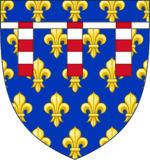 Philip Other titles List
|
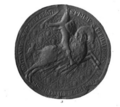 |
1 July 1336 Château de Vincennes Son of Philip VI of France and Joan of Burgundy |
1344 – 1 September 1375 |
1 September 1375 Orléans Died by natural causes (aged 39) |
Blanche of France (m. 1345; wid. 1375) Childless |
Created duke by Philip VI |
House of Valois-Orléans
The second dukedom of Orléans was created in 1392 by Charles VI of France for Louis, Count of Beaumont, younger son of Charles V of France. His role as leading figure in court, regent for his brother during his madness and wealthy landlord, as well as head of the Armagnac party, permitted his descendant to maintain a prominent role in French politics. His grandson Louis XII became king after the extinct of the direct Valois in 1498,[3] while his great-grandson Francis I succeeded the last in 1515.[4] The direct line of Valois-Orléans became extinct with the death of Louis XII in 1515, although the dukedom of Orléans was integrated among the crown's properties after his ascent to the throne in 1495.
| Duke | Birth | Tenure | Death | Marriage(s) Issue |
Claim | |
|---|---|---|---|---|---|---|
 Louis I Other titles List
|
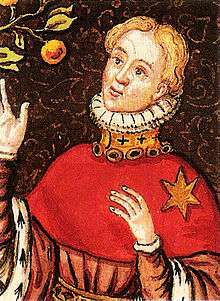 |
13 March 1372 Hôtel Saint-Pol, Paris Son of Charles V of France and Joanna of Bourbon |
4 June 1392 – 23 November 1407 |
23 November 1407 Le Marais, Paris Murdered by Duke of Burgundy's hitmen (aged 35) |
Valentina Visconti (m. 1389; wid. 1407) 8 children |
Created duke by Charles VI |
.svg.png) Charles I Other titles List
|
.jpg) |
24 November 1394 Hôtel Saint-Pol, Paris Son of Louis I and Valentina Visconti |
23 November 1407 – 5 January 1465 |
5 January 1465 Château d'Amboise Died of natural causes (aged 70) |
(1) Isabella of France (m. 1406; d. 1409) 1 children (2) Bonne of Armagnac (m. 1410; d. 1430/35) Childless (3) Maria of Cleves (m. 1440; wid. 1465) 3 children |
Son of Louis I (male-blood proximity) |
.svg.png) Louis II Other titles List
|
 |
27 June 1462 Château de Blois Son of Charles and Maria of Cleves |
5 January 1465 – 7 April 1498 (Merged into the Crown titles) |
1 January 1515 Hôtel des Tournelles, Paris Died of gout (aged 52) |
(1) Joan of France (m. 1476; ann. 1498) Childless (2) Anne of Brittany (m. 1498; d. 1514) 2 children (3) Mary of England (m. 1514; wid. 1515) Childless |
Son of Charles (male-blood proximity) |
House of Valois-Angoulême
The third dukedom of Orléans was created by Francis I for his second son Henry at his birth. When Henry's elder brother and Dauphin, Francis, Duke of Brittany, died childless in 1536, Henry substituted him as Dauphin and ceded the title to his younger brother Charles, Duke of Angoulême, who died childless in 1545.
| Duke | Birth | Tenure | Death | Marriage(s) Issue |
Claim | |
|---|---|---|---|---|---|---|
.svg.png) Henry I Other titles List
|
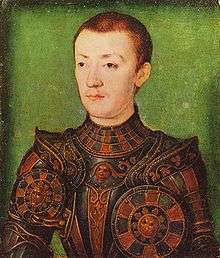 |
31 March 1519 Saint-Germain-en-Laye Son of Francis I of France and Claude of France |
31 March 1519 – 10 August 1536 (Renounced the title to become Dauphin) |
10 July 1559 Place des Vosges, Paris Accidentally killed in a joust (aged 40) |
Catherine de' Medici (m. 1533; wid. 1559) 10 children |
Created duke by Francis I |
.svg.png) Charles II Other titles List
|
.jpg) |
22 January 1522 Saint-Germain-en-Laye Son of Francis I of France and Claude of France |
10 August 1536 – 9 September 1545 |
9 September 1545 Forest-Montiers Died by influenza (aged 23) |
Unmarried | Brother of Henry I (Elevated by Francis I) |
The fourth dukedom was created by Henry II for his son Louis at his birth. The child duke, however, died one year later, and the title passed to his recently born brother Charles, who became King of France in 1560.[5] The title passed to Charles' brother, Henry, Duke of Angoulême, who six years later exchanged the appanages of Orléans for the Dukedom of Anjou, becoming the heir in pectore of the Crown.[6]
| Duke | Birth | Tenure | Death | Marriage(s) Issue |
Claim | |
|---|---|---|---|---|---|---|
.svg.png) Louis III Other titles List
|
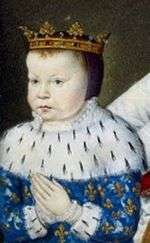 |
3 February 1549 Château of Fontainebleau Son of Henry II and Catherine de' Medici |
3 February 1549 – 24 October 1550 |
24 October 1550 Mantes Died by exposure (aged 1) |
Unmarried | Created duke by Henry II |
.svg.png) Charles III Other titles List
|
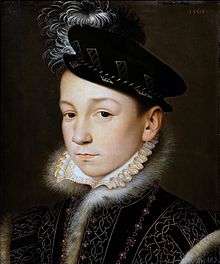 |
27 June 1550 Saint-Germain-en-Laye Son of Henry II and Catherine de' Medici |
24 October 1550 – 5 December 1560 (Renounced the title to become King of France) |
30 May 1574 Château de Vincennes Died by tuberculosis (aged 23) |
Elisabeth of Austria (m. 1570; wid. 1574) 1 child |
Brother of Louis III (Elevated by Henry II) |
.svg.png) Henry II Other titles List
|
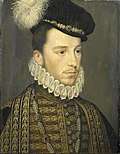 |
19 September 1551 Château of Fontainebleau Son of Henry II and Catherine de' Medici |
5 December 1560 – 8 February 1566 (Exchanged the title for the appanage of Anjou) |
2 August 1589 Château de Saint-Cloud Assassinated by Jacques Clément (aged 37) |
Louise of Lorraine (m. 1570; wid. 1574) |
Created duke by Charles IX |
House of Medici
After Henry's exchange of appanages, Charles IX gave the Orléanais to his mother Catherine, former Queen of France, as reward for his role as regent, mainly about toleration politics. She was the only suo jure Duchess of Orléans, so is included among the ruling dukes.[7]
| Duke | Birth | Tenure | Death | Marriage(s) Issue |
Claim | |
|---|---|---|---|---|---|---|
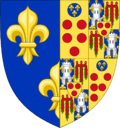 Catherine (suo jure) Other titles List
|
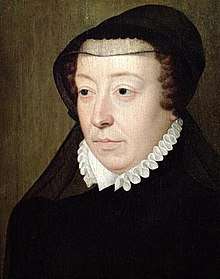 |
13 April 1519 Palazzo Pitti, Florence Daughter of Lorenzo, Duke of Urbino and Madeleine de La Tour d'Auvergne |
8 February 1566 – 5 January 1589 |
5 January 1589 Château de Blois Died by pleurisy (aged 69) |
Henry II of France (m. 1533; d. 1559) 10 children |
Created duchess by Charles IX |
First House of Bourbon-Orléans
The fifth dukedom was created in 1626 by Henry IV for his third son Gaston, Duke of Anjou.[8] Gaston became a libertine and scheming figure at court, plotting the assassination of Cardinal Richelieu and later joining the Fronde, a coalition of nobles who opposed the royal centralisation. Finally forgiven by his brother Louis XIII, he died without male heirs, extinguishing the first Bourbon House of Orléans.
Notes: the Monsieur d'Orléans, second son of Henry IV isn't included in the list due to his short life (4 years) and lack of official baptism or name.[9]
| Duke | Birth | Tenure | Death | Marriage(s) Issue |
Claim | |
|---|---|---|---|---|---|---|
 Gaston Other titles List
|
.jpg) |
24 April 1608 Château of Fontainebleau Son of Henry IV of France and Marie de' Medici |
6 August 1626 – 2 February 1660 |
2 February 1660 Château de Blois Died by natural causes (aged 51) |
(1) Marie of Bourbon (m. 1626; d. 1627) 1 children (2) Marguerite of Lorraine (m. 1632; wid. 1660) 5 children |
Created duke by Henry IV |
Second House of Bourbon-Orléans
The sixth and final creation was for Philip, Duke of Anjou, who received the Orléans by his brother Louis XIV. Through his marriage with Elizabeth Charlotte of the Palatinate, he established a long dynasty that finally arose to the throne in 1830, with the deposition of Charles X and the proclamation of Louis Philippe I.[10] Louis Philippe passed his title to his son and Daphin, Ferdinand, Duke of Chartres, who died in a carriage accident in 1842.[11]
Notes: Prince Philip (1869–1926) used the title Duke of Orléans as courtesy one.
| Duke | Birth | Tenure | Death | Marriage(s) Issue |
Claim | |
|---|---|---|---|---|---|---|
 Philip I Other titles List
|
.jpg) |
21 September 1640 Saint-Germain-en-Laye Son of Louis XIII of France and Anne of Austria |
10 May 1661 – 9 June 1701 |
9 June 1701 Château de Saint-Cloud Died by stroke (aged 60) |
(1) Henrietta of England (m. 1661; d. 1670) 3 children (2) Elizabeth Charlotte of the Palatinate (m. 1671; wid. 1701) 3 children |
Created duke by Louis XIV |
 Philip II Other titles List
|
 |
2 August 1674 Château de Saint-Cloud Son of Philip I and Elizabeth Charlotte of the Palatinate |
9 June 1701 – 2 December 1723 |
2 December 1723 Palace of Versailles Died by natural causes (aged 49) |
Françoise Marie de Bourbon (m. 1692; wid. 1723) 8 children |
Son of Philip I (male-preference proximity) |
 Louis Other titles List
|
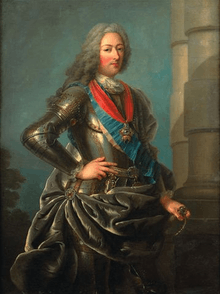 |
4 August 1703 Palace of Versailles Son of Philip II and Françoise Marie de Bourbon |
2 December 1723 – 4 February 1752 |
4 February 1752 St. Genevieve, Paris Died by delirium complications (aged 48) |
Johanna of Baden-Baden (m. 1724; d. 1726) 8 children |
Son of Philip II (male-preference proximity) |
 Louis Philippe I Other titles List
|
_as_Duke_of_Orl%C3%A9ans_by_Alexander_Roslin%2C_Stockholm.png) |
12 May 1725 Palace of Versailles Son of Louis and Johanna of Baden-Baden |
4 February 1752 – 18 November 1785 |
18 November 1785 Château de Sainte-Assise Died by natural causes (aged 60) |
Louise Henriette de Bourbon (m. 1743; d. 1759) 3 children Morganatic: Charlotte-Jeanne Béraud (m. 1773; wid. 1785) Childless |
Son of Louis (male-preference proximity) |
 Louis Philippe II Other titles List
|
 |
13 April 1747 Château de Saint-Cloud Son of Louis Philip I and Louise Henriette de Bourbon |
18 November 1785 – 6 November 1793 |
6 November 1793 Conciergerie, Paris Executed for treason (aged 46) |
Marie-Adélaïde de Bourbon (m. 1768; wid. 1793) 5 children |
Son of Louis Philip II (male-preference proximity) |
 Louis Philippe III Other titles List
|
 |
6 October 1773 Palais-Royal, Paris Son of Louis Philip II and Marie-Adélaïde de Bourbon |
6 November 1793 – 9 August 1830 (Renounced the title to become King of the French) |
26 August 1850 Claremont, England Died by natural causes (aged 76) |
Maria Amalia of Naples and Sicily (m. 1809; wid. 1850) 10 children |
Son of Louis Philip II (male-preference proximity) |
 Ferdinand Other titles List
|
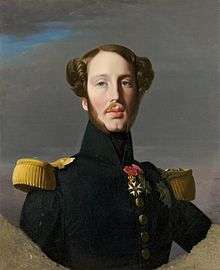 |
3 September 1810 Royal Palace, Palermo Son of Louis Philip III and Maria Amalia of Naples and Sicily |
9 August 1830 – 13 July 1842 |
13 July 1842 Neuilly-sur-Seine Died in an accident (aged 31) |
Helene of Mecklenburg (m. 1837; wid. 1842) 2 children |
Son of Louis Philip III (male-preference proximity) |
Current use
- Legitimists recognize Jean, Count of Paris, Head of the House of Orléans, as Duke of Orléans, inheriting the title as the heir male of Philip I, Duke of Orléans.
- Orleanists recognize Jacques d'Orléans, uncle of the Count of Paris, as Duke of Orléans. Per Orleanist reckoning, the title has merged with the crown. Jacques is the younger fraternal twin brother of Michel d'Orléans. According to Orleanists, the last of twins to be born is the first-born. Thus, Jacques is considered the eldest uncle of the Count of Paris, whom they consider the king.
See also
- Duchess of Orléans
- Count of Orléans
- Orleanist
- Legitimist
- Dauphin of France
- Duke of York
References
-

- Amédée René, Les princes militaires de la maison de France, Paris, 1848, p. 49
- Didier Le Fur, Louis XII : un autre César, Perrin, 2001 p. 40.
- Auguste Bailly, François Ier : restaurateur des lettres et des arts, Livre club du librairie, 1961, p. 9.
- Jean Heritier, Catherine de Medici. George Allen and Unwin, 1963, p. 69.
- Nicolas Le Roux, «La cour dans l'espace du palais: l'exemple de Henri III», Palais et pouvoir, de Constantinople à Versailles, Presses universitaires de Vincennes, 2003, pp. 106-108.
- Knecht, R. J. Catherine de' Medici. London and New York: Longman, 1998, 104-108.
- A.L. Moote, Louis XIII, The Just p 192. University of California Press, 1991, p. 192.
- François de Malherbe, Lettres à Peiresc, éd. La Pléiade, p. 378.
- "Louis-Philippe Biography". The Biography.com Website. Retrieved 13 May 2014.
- Unwin, Brian (2014). A Tale in Two Cities: Fanny Burney and Adèle, Comtesse de Boigne. New York: I.B. Taurus & Co. pp. 210–212. ISBN 978 1 78076 784 0.